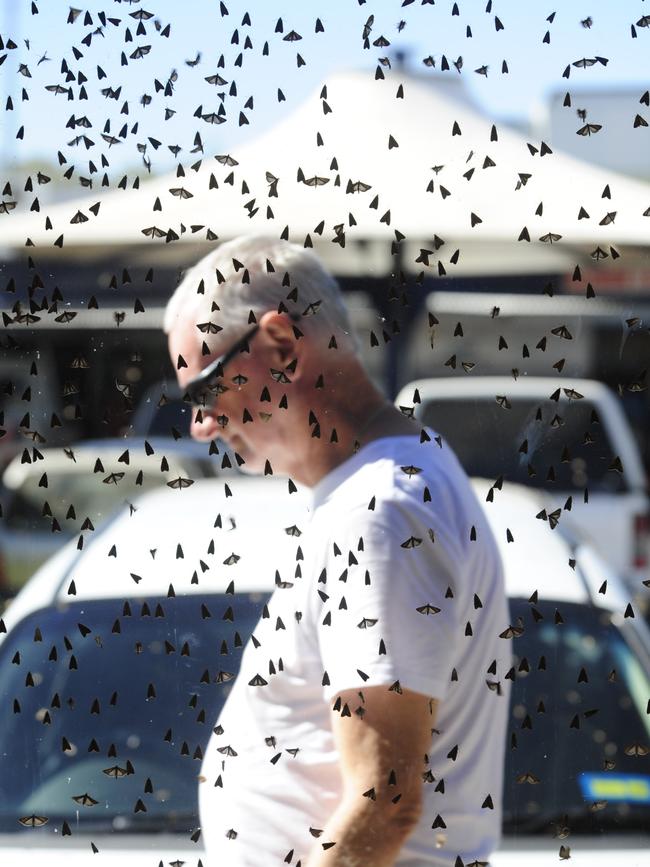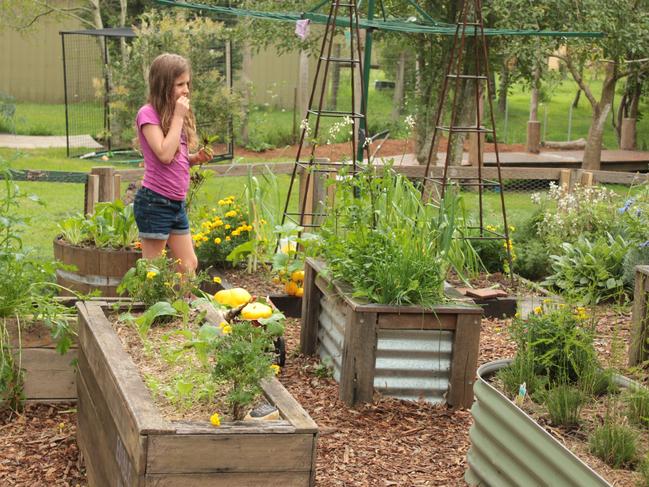Gardening Australia: Costa Georgiadis explains how to grow your invisible garden, best ‘risky’ garden for kids, winning the war on insects
Spring is here and that means the mother of all seasonal comebacks – insects. This is how to win the war on the pests.
Property
Don't miss out on the headlines from Property. Followed categories will be added to My News.
As the weather warms up, so does the insect population.
While we can all appreciate the value of bees, butterflies and ladybirds in the garden, the ones that make themselves at home in our kitchens and bedrooms, chomping down on our favourite foodstuffs and clothes, are less welcome. If you find yourself under attack, help is at hand with these non-toxic solutions.
CLOTHES MOTHS: HOW TO GET RID OF THEM
It’s incredibly annoying to pull one of your jumpers out of the wardrobe only to discover it has holes in it. Clothes-eating insects tend to be fancy little creatures, opting almost exclusively for natural fibres like cotton and cardboard, in the case of silverfish, and wool, fur and silk, for clothes moths.

Their presence is often not easily detected because silverfish are generally only active at night while it is the larvae of the clothes moths that like to chow down on your favourite woollens and even your wool carpet.
With clothes moths, sometimes you might see evidence of webbing, often in the darkest corners, where they have laid their eggs. To get rid of clothes moths, experts recommend removing your clothing, and vacuuming and wiping out the cupboard. If it’s practical, put affected clothing in the freezer for a week or two, which will kill the larvae and eggs. Steer clear of traditional mothballs, which contain chemicals anyway. Try placing camphor balls, sachets of lavender or a mix of bay leaves and cloves in your cupboards among your clothing. Over spring and summer, putting your jumpers in vacuum sealed bags will protect them from attack.

HOW TO STOP PANTRY MOTHS
Pantry moths, also known as Indian meal moths, are easier to spot than clothes moths but can be just as tricky to get rid of. You might see these little insects flying about but they have an annoying habit of laying their eggs in everything, from flour and rice to meal products, nuts and cereal packets to feed their larvae.
Firstly, you can kiss anything infested with pantry moths goodbye. Foodstuffs in unopened packets can be frozen for a week or two to kill larvae and eggs. Then, you need to clean out and wipe down the pantry using hot soapy water.
Sticky pheromone traps can be good for attracting any moths you’ve missed. Some suggest investing in sealable containers to put things like flour and rice in but I’ve found this a bit hit and miss because those moths are incredibly good at getting into even the smallest crevices.
Try screw top jars instead. A few dried bay leaves tied together and hung in your pantry can be a good ongoing deterrent.

SILVERFISH CONTROL: HOW TO ENSURE THEY DON’T TAKE OVER YOUR HOME
These little insects don’t stop at your clothing. They will eat cereal boxes, books, wallpaper, you name it. They can also live for several years and they’re incredibly tough. But they do rely on moisture for survival so keeping an eye on damp and humidity in your house is a good start. They can come into houses via infested books or cardboard boxes, so be vigilant for anything that looks a bit damaged.
Also, dispose of anything you find showing signs of infestation. Regular and thorough vacuuming will also help keep on top of the problem. Be aware that eggs and larvae might be picked up by your vacuum cleaner so, if you have a bagless vacuum, empty it into a plastic bag outside your house. There are barrier products on the market but if you have a serious infestation, you might need to call in a pest controller.

THE ‘RISKY’ GARDEN YOUR KIDS WILL LOVE
If you listened to real estate agents, central to the backyard would be a large expanse of lawn on a level site.
But with space at a premium and flat sites in short supply, not everyone has access to a lot of lawn. The good news is director of Edible Kids Gardens, Steve Webb, says gardens on less-than-even sites can be far more engaging for children than a flat piece of lawn.
And he should know.
As a landscape architect and permaculturalist, he has been creating playgrounds, outdoor learning spaces and sensory gardens for schools and private gardens to spark kids’ imaginations and encourage them to test their limits.

Q. We have three young children and a decent sized backyard, but it’s not level. I’m worried the kids might hurt themselves If we don’t level it out, what are our options? I still want it to look beautiful.
A. A sloped, steep or uneven site for kids is great for developing healthy risk-taking, the need that kids have to challenge themselves and assess their environments, and build mastery by overcoming difficult physical terrains.
This is especially the case during lockdown where many kids find themselves confined to the indoors, or limited for short periods to designated playgrounds and parks. It is a tragic irony that in the age of compelling computer simulation in games in which kids dig and forge things and jump off cliffs, that in the real world they have very little lived experience of these things.
We tell clients that the aim of our designs is to create open-ended learning where the potential for harmful accidents is minimised but risk is still present.
Risk provides the opportunity for children to test their limits and challenge themselves, thereby developing autonomy and self-confidence. So, we do not guarantee that the environments we install will not result in injuries, and we expect competent adults to adequately supervise children as they use and enjoy the environment.

Q. Our yard is significantly sloped. Should we try to level out the site or not worry?
A. A backyard on a slope doesn’t have to be simply left unstructured, or excessively fenced off so that significant drops are out of access to kids. One of the most beautiful features in a garden is the use of stone, logs and timber to create walls to create a terrace and add manageable steps directly into the slope, whether these are rustic dry stacked walls or more precise structural walls.
Mosses and lichen add an aged beauty and patina too. Trailing plants can be positioned to show off the foliage and flowers or make the fruit more pickable, while hiding walls which are less aesthetically pleasing. Significant slopes and changes in level provide an obvious location to position a slide, climbing wall or cargo net, with soft fall material such as pine bark mulch or impact rubber (usually from recycled tyres) at the correct thickness needed to cushion the blow when kids fall down.

I like to work with the existing constraints of a site to achieve a design that feels right and works in terms of basic things like slope, run-off, bogginess, aspect and existing materials.
A heavy-handed bulldozing and building massive retaining-walls approach to create flat areas not only lacks sensitivity, it is a sure way to burn through the budget very quickly.
A kid scale garden is one which has lots of smaller spaces rather than one big space.
It’s a garden with nooks and hidey-holes with cubbies under shrubs and trees. A garden is much more interesting when there is more to discover than what you can see from the back door.
A sloped site has many advantages in terms of creating these kinds of special spaces where kids have free rein, indeed being hard to access by adults makes it particularly desirable for a child. Unfortunately, in an age of extreme regulatory procedures, there are few of these forgotten, hidden spaces where children are allowed to spend any meaningful time.
WHAT TO DO WITH YOUR ‘INVISIBLE’ GARDEN
If there’s a pastime that has gained momentum during the past 18 months, it’s gardening.
With so many of us working from home, growing something, whether it’s just a succulent in a pretty pot or a thriving vegetable garden that’s helping to feed the family, has become a deeply satisfying way of reconnecting with nature and also the neighbourhood.
Gardening Australia host and landscape architect, Costa Georgiadis, says your garden offers plenty of opportunities for pleasure and getting to know your neighbours, even if you only
have your nature strip, or verge, to work with.
Here, he explains the unexpected joys of taking gardening to the streets.
WHY CREATE A VERGE GARDEN?
There’s kilometres of weed-infested, semi grass-covered areas filling our suburbs that really offer nothing in terms of rain absorption, biodiversity and habitat for insects and birds. For a lot of people, the verge or nature strip is an overgrown wasteland. I see it as a potential to grow corridors of habitat and beauty for everyone to appreciate.
WHAT MAKES A GOOD VERGE GARDEN?
It has a mixture between groundcovers that help to reduce erosion and run off as well as a nice mixture of flowering plants that bloom across all the seasons, not only for passers-by but also as some sort of floral service for birds and insects.
When you create something even in just the smallest of areas, just one or two square metres, and you see the impact that it has, you might see an insect come visit something you planted, that’s an incredible joy.
Those small moments can tie into the bigger environmental picture.
You can contribute to citizen science by signing up to programs such as the Aussie Backyard Bird Count or the Australian Museum’s FrogID Project. When you provide habitat, you are participating in a rewilding of our cities. That is one of the highest order pastimes you can participate in.
It’s not something we can do alone but every little piece of the jigsaw adds up. Your three square metres of nature strip then becomes just as valuable as the bushland at the end of your street because they are part of the green corridors. Our streets are valuable arteries for refuelling of wildlife.
When we have healthy, luscious gardens with canopy, we can also change the temperature because it impacts on the coolness of the air.
IS SHARING PRODUCE WITH NEIGHBOURS A GOOD IDEA?
Absolutely and there are so many ways to share edibles.
Things like perennial basil and silver beets or warrigal greens which are all hardy, long-lasting plants provide ‘pluck and pick’ opportunities. A rosemary hedge is a simple way to provide for everyone in the street. There’s usually enough to take a little piece most nights. All through Covid I had amaranth growing, which I was harvesting every second night to steam it as a side dish.
Plus, with many plants, the more you pick them, the more they will grow.
WHAT’S THE BEST WAY TO PUT YOUR PRODUCE OUT FOR THE NEIGHBOURS?
There are so many things you can find during council clean-ups, like drawers or shelves, that you can attach to your fence, or a box by the gate to put your produce in. You can put a little water in jars and add a sign saying ‘free herbs for tonight’. You can make a Crop Swap stand.
They have groups all round Australia.
There’s a laneway in Ballarat where people bring cuttings, pots and share pot plants. I have a street library outside my house in Sydney and a shared waste system on my nature strip where people can bring their scraps.
ShareWaste has hosts all over.
HOW DO YOU CREATE A FRONT GARDEN THAT ENCOURAGES INTERACTION WITH THE NEIGHBOURS?
The best thing is just being out the front and saying hello to people as they pass.
They might not say anything the first time, or even the second time. They might have earbuds in, which is often the case, but keep trying. The key is to ditch the ego and throw a ‘hello’ out there. Sooner or later, they’ll respond.
I had someone run past a while back who was peeved because my waste bucket was in his way. The next time, I said hello as he ran past and eventually, we started talking.
Your garden is being observed all the time, whether you are there or not.
My young neighbours down the street watched the garden during Covid and they would come by to say goodnight to the worms. They come in the gate to see the chickens, or the frogs, which are going off right now.
The verge is like a wonderland.
Those sorts of experiences are where we can have an influence. One lady told me that my garden was cool, literally. She felt the air cool as she passed. During Covid there were hundreds of people walking by so I planted native paper daisies and I made a woven willow fence, which people loved.
It’s inspiring people to look at the world around you and see the changes that happen seasonally. All the little details are what invite and entice the neighbours to participate.
I planted a whole section of sunflowers and my neighbour took some of them to the surgery where she works.
There are so many ways a street garden can touch people’s hearts. Your garden can connect with others and break down barriers by creating little moments.
The Fixer is here to answer all your home improvement, renovation and repair questions.
Email us at athome@news.com.au
Originally published as Gardening Australia: Costa Georgiadis explains how to grow your invisible garden, best ‘risky’ garden for kids, winning the war on insects




